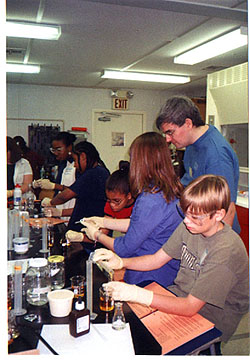



|
|

Twenty 7th-grade students from Harnett Central Middle School had the opportunity to come to Campbell University for three Saturdays in the fall. They participated in three seperate laboratory experiences. The first prepared a decoction and percolation. They compared ginger and garlic extracts to see which one was the better antibiotic. The second lab involved DNA extraction. The students used onions, wheat germ and calf liver as sources of DNA to see which material would yield more DNA. In the third lab the students used PCR to prepare a DNA fingerprint of DNA from their own saliva. The Mystery Plant component of the program was a 3-month endeavor. The students planted seeds and grew them up. They used information about leaves, roots and seedlings to identify what they had planted. They kept notebooks that recorded the plant's progress and any additional research they had done. The student who correctly identified the plant and kept the best notebook was eligible for the grand prize. The final component of this program will be a field trip to a local North Carolina biotech company to see science in action.

Twenty eighth grade students had the opportunity to come to Campbell University for three Saturdays in the Spring. They participated in three separate laboratory experiences. In the first they explored electricity in the physics lab. They used oranges and potatoes to make a battery and tested it with a multitester. Students were also able to use a galavanometer, a oscilloscope and a signal generator to understand more about voltage and current. In the second lab the students worked with water samples that they brought from home to test water quality for pollutants. They tested the samples for nitrates, phosphates, dissolved oxygen and alkalinity. The last lab also involved water samples. This time the students used HPLC to test the samples for herbicide contamination. The other component of the 8th graders program was a take home project. The students had seven samples of clear liquids. They designed experiments to do at home that would let them determine which sample was plain water. They used, thermometers, pH paper, ice, salt and a variety of other household materials. The student who correctly identified his/her water sample and kept the best data notebook was eligible for the grand prize. At the end of the program all the students went on a field trip to the North Carolina Food and Drug Protection Division Laboratories and the North Carolina Department of Agriculture Soil Testing Laboratories.
![]() Last Modified:
Last Modified: